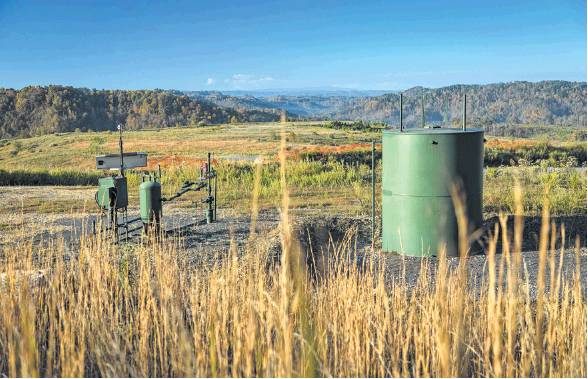Energy fund goes broke
Houston-based EnerVest loses $2 billion as bust keeps hurting
By Jordan Blum and Ryan Maye Handy
The Houston investment firm EnerVest is selling oil and gas holdings to fend off creditors after the value of a $2 billion hedge fund launched during the oil boom plunged to almost nothing as the effects of the worst oil bust in a generation are still felt.
The stakes of some the nation’s biggest institutional investors, including foundations and pension funds, appear all but wiped out.
EnerVest, founded 25 years ago, developed a complex financial structure and an unusual approach to investing in the energy industry, but its fund ultimately succumbed to the same miscalculations that pushed hundreds of drillers into bankruptcy during the two-year oil bust.
EnerVest bought at the top of the market and borrowed heavily to finance purchases.
“The lesson for everyone is that excessive (borrowing) in a commodity down-cycle can be lethal,” said Pavel Molchanov, an energy analyst at Raymond James in Houston. “That’s what led to EnerVest’s meltdown. No big surprise there.”
EnerVest executives brushed aside concerns about the firm’s viability, arguing that selling oil and gas properties concentrated in Texas and the Northeast would raise enough money to satisfy most of its debt and avoid a tug-of-war with Wells Fargo and other lenders over control of the embattled fund. The fund represented about one-fourth of the assets managed by EnerVest.
“We’re in active negotiations where we can divest assets, and that gets us back to close to compliance with the banks,” said Ron Whitmire, senior vice preisdent. “EnerVest is fine.”
He declined to comment on the impact on investors and what the company is telling them.
EnerVest is unique among private equity companies that offer alternative investments to large, wealthy and usually institutional investors. Rather than speculating on future oil prices, EnerVest buys what it describes as undervalued oil-and-gas-producing land and operates wells, boosting its returns by borrowing.
It launched the $2 billion fund, which it called “Fund XIII” in 2012, as the shale boom gained speed and oil made its run to $107 a barrel. Another earlier fund that caught the shale drilling wave, dubbed “Fund XII,” also lost much of its value after launching in 2011 with about $1.5 billion.
“We have two portfolio funds that are in need of repair,” Whitmire said. “We’ve got to fix those and move on.”
$10 million in fund
The Houston Municipal Employees Pension, which lists EnerVest as a financial adviser, has about $10 million invested in Fund XII. Pension funds for state employees, teachers, firefighters and police officers around the country — including in Texas, Colorado, Illinois, New Mexico and California — invested money in some of EnerVest’s funds.
The Orange County Employee Retirement System, for instance, invested $40 million in Fund XIII. The system has written down that investment to zero, according to the Wall Street Journal, which first reported the fund’s losses. Large foundations, including J. Paul Getty Trust and John D. and Catherine T. MacArthur Foundation, also had investments in the fund wiped out, the Journal reported.
Neither the retirement system nor the foundations could be reached for comment.
EnerVest is the rare private equity firm focused almost entirely on oil and gas exploration and production. The plunge in prices to $26 a barrel in February 2016 battered its funds and returns. Crude settled Monday at $46.02 per barrel.
In an interview in June, EnerVest CEO John Walker said the crash took a toll, and the firm laid off employees for the first time in its history. “Everything was going sideways,” Walker said. “We started shutting down rigs and pulling in our horns a little bit.”
Meanwhile, the stock of EnerVest’s publicly traded subsidiary, EV Energy Partners, has plunged from more than $40 a unit in August 2014 to 61 cents Monday, slashing the EV Energy’s stock market value from more than $1 billion to $30 million in a little less than three years. EV Energy recently warned investors in a regulatory filing that it faces the risk of defaulting on some of its $612 million in debt in early 2018 if it can’t work out new deals with lenders and its finances don’t improve.
In solid position
EV Energy Partners, founded in 2006 to help its parent acquire and mange oil and gas assets, operates as an exploration and production master-limited partnership, a tax-avoiding corporate structure that requires the companies to distribute most of their income to investors in payments similar to stock dividends. MLPs are most popular with pipeline companies, but EV Energy Partners is one of the few oil-and-gasproducin g MLPs.
Another Houston company used this structure and became of one fastest rising stars among investors during the oil boom. That company, Linn Energy grew rapidly, but fell hard, becoming the largest bankruptcy of the energy bust.
Whitmire contended that EnerVest is in a solid position overall because of its diversification, finding bargains in areas like South Texas’ Eagle Ford shale as other companies rush to pay dollar for land in West Texas’ Permian Basin. Another EnerVest fund launched with almost $2.5 billion in 2015, when prices for oil and gas acreage were falling, is doing well, Whitmire said.
“We’re opportunistic buyers,” he said.
L.M. Sixel and Mike Morris contributed to this report. jordan.blum@chron.com ryan.handy@chron.com

